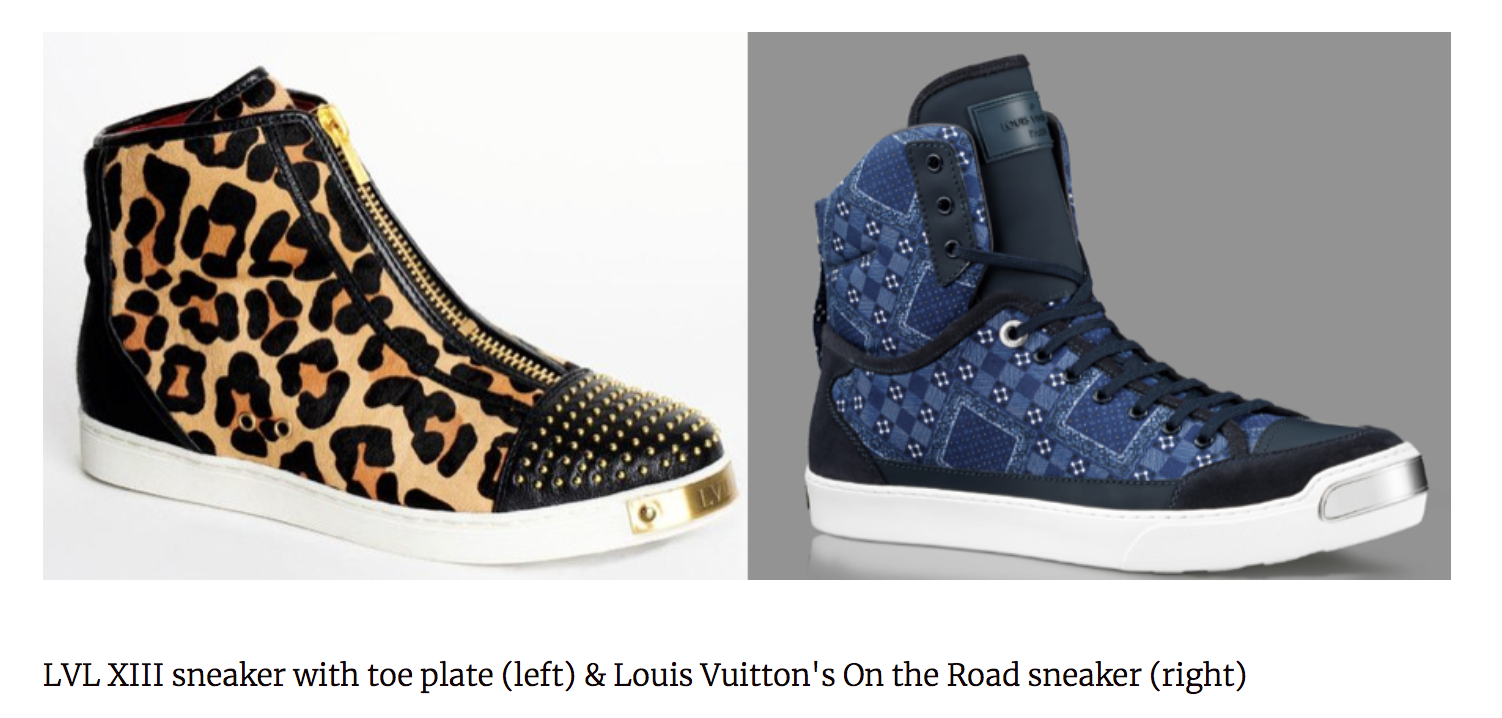A little-known footwear brand attempted to wage war against the world’s most valuable luxury brand – and unsurprisingly, it lost. Not long before releasing its first run of 1,000 sneakers and gifting some of them to the likes of Chris Brown, model Tyson Beckford, rappers Nas and Jim Jones, and a handful of pro athletes, New York-based LVL XIII got wind of Louis Vuitton’s Spring/Summer 2014 menswear collection and called, “Copy!” However, instead of using Instagram to point out the “copy” (as is oh-so-trendy nowadays), LVL XIII lawyered up and took its grievance to court.
Filing suit against Louis Vuitton in July 2014, LVL XIII alleged – in something of a head-scratching case – that Louis Vuitton was “competing unfairly” with it by selling footwear that was “confusingly similar” to its own, i.e. sneakers that included a rectangular toe place design. According to LVL XIII’s complaint, Louis Vuitton, in putting a toe plate on a few of its own Spring/Summer 2014 menswear sneakers, was “exploiting the goodwill of LVL XIII in an effort to mislead” consumers and in “a deliberate attempt to divert sales away from LVL XIII.”
After being served a blow by way of a rather strongly-worded 107-page decision in September 2016 – in which Judge Paul A. Engelmayer of New York’s Southern District Court dismissed the case, holding essentially that LVL XIII, failed to prove its case on all fronts – LVL XIII appealed the court’s decision, only to have the U.S. Court of Appeals for the Second Circuit uphold the lower court’s decision and dismiss the case (again) on Wednesday.
According to the three-judge panel for the Second Circuit, in order for LVL XIII to prevail in its case, it “would need to establish that (1) it has a “mark [that] ‘merits protection’” and (2) “the allegedly infringing use of the mark (or a similar mark) is ‘likely to cause consumer confusion.’” LVL XIII was unable to satisfy at least the first prong, according to the court, which held that while LVL XIII claimed that its toe plate has since become “distinctive in the relevant market,” in reality, the toe plate feature is “not uncommon in the relevant high-end shoe market.”

Specifically, the court held that LVL XIII’s toe plate has not developed secondary meaning. Since LVL XIII’s toe plate is not inherently distinctive (because it is a product design feature), it would need to boast secondary meaning to enjoy trade dress protection.
For the uninitiated, the U.S. Supreme Court held in 2000 that product design trade dress, such as LVL XIII’s toe plate, is never inherently distinctive and so, to be eligible for trade dress protection, the product design have achieved secondary meaning. “Second meaning” means that an average consumer associates the design element at issue with the brand from which it originates. In short: Just as a consumer who sees a Birkin bag knows it originates from Hermès, the average must be able to associate the LVL XIII toe plate with the LVL XIII brand in order to it to claim trade dress protection over it. This is, of course, no small feat.
In the Second Circuit, the following six factors are used to determine whether a mark has developed a secondary meaning: (1) advertising expenditures, (2) consumer studies linking the specific trademark or trade dress to the brand/source, (3) unsolicited media coverage of the specific product, (4) sales success of that product, (5) attempts by others to copy the trademark/trade dress at issue, and (6) the length of time the trademark/trade dress has been used and the level of exclusivity associated with the trademark/trade dress use.
Because LVL XIII was unable to satisfy this prong (as the Southern District of New York court spoke to at length), thereby establishing that its toe plate “mark does not merit protection under the [federal trademark] statute,” the court held that it need not even consider whether consumers are likely to be “confused by the similarity of [LVL’s and Louis Vuitton’s] marks.”
The end. Finally.










